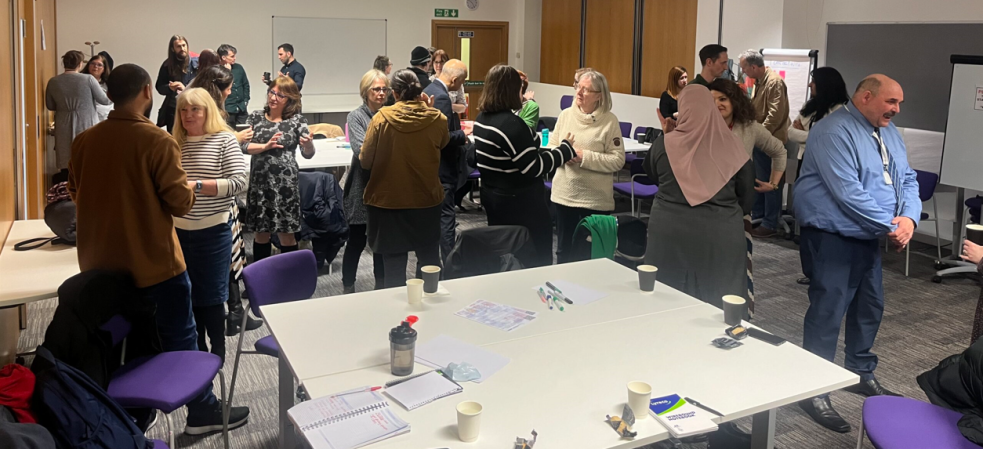The CoREN: Bridging the Gap Between Research and Communities
In this guest blog, Lancaster University's Steven Dodd, examines the progress of the Community Research and Engagement Network (CoREN) in advancing participatory approaches within health and social care research.

The benefits of participatory approaches to research are increasingly acknowledged, but creating institutions to realise and sustain participatory research ideals in practice is no easy task. An important player in turning ideals into reality in North West England is the Community Research and Engagement Network (CoREN). Funded by the National Institute for Health and Care Research (NIHR), and part of the Applied Research Collaboration for the Northwest Coast (ARC NWC), it spans an area from South Cumbria to Cheshire.
CoREN was created to fuel collaboration in health and social care research between voluntary, community, faith and social enterprise (VCFSE) groups, community members, health and social care practitioners, and academic researchers. This mission also involves raising the profile of community health priorities, increasing community research knowledge and research-readiness, and contributing to reducing health inequalities. Unlike short-term, project-bound co-production initiatives, the CoREN is intended as a sustainable and lasting foundation for building research relationships. Its leadership group, comprising representatives from VCFSE organisations, researchers, and public advisers, symbolises its commitment to participatory principles, with the group playing a key role in decision making over the CoREN’s direction.
Building Bridges: The CoREN as a Conduit for Collaboration
A key finding of the evaluation was the success of the CoREN in its role as a catalyst for collaboration, connecting stakeholders who might otherwise remain siloed. Participants in the evaluation frequently discussed this role, describing the CoREN as a “conduit for collaboration” which brings together a wide range of stakeholders, helping them identify shared research priorities and develop solutions collaboratively. For example, it hosts ‘collaboration cafés’, where community members, researchers, and practitioners come together to share insights, discuss research priorities, collaboratively develop research projects, and build relationships.
The CoREN’s success in the bridging role is not just a matter of facilitating introductions but also of promoting an equitable basis for collaboration by equipping community representatives with the skills, confidence, and knowledge needed to take an active role in shaping research. Through initiatives like collaborative mentoring, where researchers and community members exchange insights and take turns as mentor and mentee, the CoREN equips community members with the knowledge and confidence to engage in the research process.
At the same time, researchers gain confidence and develop skills in collaborating effectively with communities. Initiatives like this model the power-sharing that the CoREN seeks to promote, with egalitarian and reciprocal exchanges of information taking the place of traditional hierarchical research-participant relationships, and community representatives seen as equal partners in research, rather than as passive participants.
The CoREN’s success in the bridging, intermediary role, leads to a growing network which is itself a draw for new collaborators, with its growing profile serving to attract the interest of others and further grow the network. Not only does this provide an attractive platform for prospective members, but through its growing network of participants, the CoREN can provide an excellent signposting resource for researchers seeking community input, or for practitioners or community representatives wishing to raise the profile of an issue.
Promoting Inclusion and Building Synergies Across Boundaries
This signposting function of the CoREN is particularly important in its efforts to connect underrepresented communities with researchers, offsetting their usual exclusion from research processes. For example, evaluation participants pointed out its success in connecting researchers with marginalised populations such as Traveller, Gypsy, and Roma communities. These communities may not have the trust to engage with researchers independently, but through the CoREN’s intermediary role, they are able to contribute their perspectives to research. Participants in the evaluation pointed out that these connections not only serve the interests of the communities involved but also address blind spots in academic research, which is often shaped by less diverse perspectives.
Sustaining Momentum: Challenges and Opportunities
The CoREN’s strength lies in its ability to act as an intermediary that facilitates partnership synergies - where the combined resources and perspectives of multiple stakeholders lead to outcomes that none could achieve alone. Participants in the evaluation frequently highlighted the unexpected connections and opportunities that emerged through the CoREN’s work, with one researcher comparing it to “planting seeds and watching the oak tree grow.” This metaphor captures the long-term, facilitative and generative nature of CoREN’s impact, offering a powerful model for others wishing to pursue innovative approaches to co-production. Yet, its work is far from finished.
In a climate in which non-participatory research practices are still the default approach, the CoREN’s progress in maximising its geographical and cultural reach, communicating its decentralised organisational structure, and continuing to push for deeper community involvement in all stages of research will be critical to the advancement of the co-production agenda in North West England.
This blog summarises findings from a recent evaluation of the CoREN which used a mixed-methods approach to explore its role, impact, and areas for improvement. Data were collected from 48 participants, including leadership group members, researchers, and community representatives, through online surveys, interviews, and focus groups.
The views expressed in this blog are those of the author(s) and not necessarily those of the National Institute for Health Research or the Department of Health and Social Care.